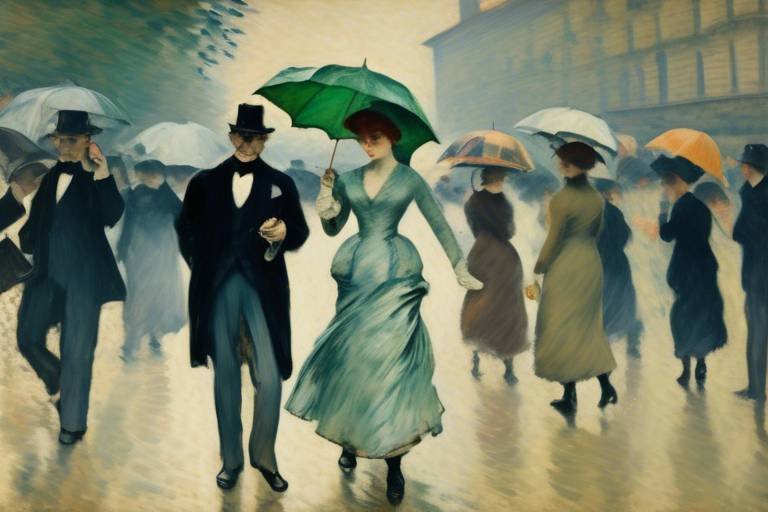The Cultural Impact of Art Nouveau in Europe
Art Nouveau, a revolutionary artistic movement that swept through Europe during the late 19th and early 20th centuries, left an indelible mark on the cultural landscape of the continent. This innovative style, characterized by its embrace of nature, flowing lines, and intricate details, redefined the boundaries of art, architecture, and design.
Originating as a reaction against the industrialization and mechanization of the era, Art Nouveau drew inspiration from the Arts and Crafts movement, aiming to create a holistic approach to design that encompassed all aspects of daily life. It sought to break free from the constraints of traditional artistic forms and embrace a new aesthetic that celebrated individuality and craftsmanship.
The key characteristics of Art Nouveau are unmistakable - organic forms, asymmetrical shapes, intricate patterns, and a profound connection to the natural world. This artistic style often featured motifs inspired by plants, flowers, and female figures, exuding a sense of elegance and sensuality.
Art Nouveau's influence extended beyond the confines of traditional art galleries and studios, permeating into the realm of architecture. Visionary architects such as Victor Horta and Antoni Gaudí pushed the boundaries of building design, incorporating innovative materials, curvilinear structures, and decorative elements inspired by nature.
In the visual arts, luminaries like Alphonse Mucha and Gustav Klimt embraced the Art Nouveau style, infusing their paintings, sculptures, and graphic works with its distinctive flair. Their creations reflected the movement's emphasis on beauty, symbolism, and the fusion of art with everyday life.
Furthermore, Art Nouveau's impact on decorative arts was profound, influencing interior design, furniture, jewelry, and glassware. Artisans and designers embraced the movement's ornamental and elegant aesthetic, creating pieces that blurred the line between art and functionality.
As Art Nouveau spread across Europe, it adapted to local cultures and traditions, influencing artistic movements in countries such as France, Belgium, Spain, and Austria. Each region added its unique twist to the style, resulting in a rich tapestry of artistic expression that transcended national boundaries.
The legacy of Art Nouveau endures to this day, with its influence still visible in contemporary design. From the intricate facades of buildings to the elegant curves of furniture, the spirit of Art Nouveau lives on, a testament to the enduring power of artistic innovation and creativity.

Origins of Art Nouveau
The origins of Art Nouveau can be traced back to a time of significant change in Europe, particularly during the late 19th and early 20th centuries. Emerging as a reaction against the industrial revolution, this artistic movement sought to break away from the mass-produced, machine-made goods of the time. Instead, it embraced a return to craftsmanship and the handmade, drawing inspiration from nature and the natural world.
One of the key influences on Art Nouveau was the Arts and Crafts movement, which emphasized the importance of creating a total work of art that unified all aspects of design, from architecture to furniture to decorative arts. This holistic approach to creativity laid the foundation for the intricate and ornate style that would come to define Art Nouveau.
Art Nouveau artists and designers were driven by a desire to infuse beauty and artistry into everyday objects, elevating the mundane to the extraordinary. They sought to blur the lines between art and life, creating a harmonious environment where every element, from a chair to a building facade, was a work of art in its own right.

Key Characteristics of Art Nouveau
Art Nouveau, known for its distinctive style and innovative approach, is characterized by several key features that set it apart from other art movements of its time. One of the most prominent aspects of Art Nouveau is its emphasis on organic forms inspired by nature. Artists and designers sought inspiration from the natural world, incorporating elements like flowers, plants, and flowing lines into their creations.
Another defining characteristic of Art Nouveau is its use of asymmetrical shapes and designs. Unlike the symmetrical and balanced compositions of previous styles, Art Nouveau embraced asymmetry to create a sense of movement and dynamism in art and architecture.
The movement is also known for its intricate patterns and ornate details, often featuring elaborate motifs and decorative elements. These intricate designs added a sense of luxury and sophistication to Art Nouveau creations, making them visually captivating and rich in detail.
Furthermore, Art Nouveau placed a strong emphasis on the natural world and the representation of female figures. Artists frequently depicted women in flowing, ethereal forms, celebrating femininity and nature in their works.
Overall, the key characteristics of Art Nouveau, including organic forms, asymmetrical shapes, intricate patterns, and a focus on nature and female figures, contributed to the movement's unique and influential aesthetic that continues to inspire artists and designers to this day.

Influence on Architecture
Art Nouveau had a profound influence on architecture, reshaping the way buildings were designed and constructed. Architects like Victor Horta and Antoni Gaudí played pivotal roles in revolutionizing architectural norms, incorporating the distinctive features of Art Nouveau into their creations.
One of the key aspects of Art Nouveau architecture was the use of innovative materials. Instead of relying solely on traditional building materials, architects began to experiment with new materials, pushing the boundaries of what was considered possible in construction.
Curvilinear structures became a hallmark of Art Nouveau architecture, with buildings featuring flowing lines and organic forms inspired by nature. These structures deviated from the rigid, straight lines of previous architectural styles, creating a sense of movement and dynamism in the built environment.
Decorative elements also played a significant role in Art Nouveau architecture. Intricate patterns, ornate detailing, and elaborate motifs adorned the facades and interiors of buildings, transforming them into works of art in their own right.
Furthermore, the integration of nature into architectural design was a central tenet of Art Nouveau. Buildings often featured motifs of plants, flowers, and other natural elements, blurring the line between the built environment and the natural world.
Overall, the influence of Art Nouveau on architecture was far-reaching, challenging conventional norms and paving the way for a new era of design that celebrated creativity, individuality, and the beauty of the natural world.

Impact on Visual Arts
Art Nouveau had a profound impact on the visual arts during the late 19th and early 20th centuries. This artistic movement, characterized by its focus on organic forms and intricate patterns, influenced various forms of visual expression, including painting, sculpture, and graphic arts.
One of the most prominent artists associated with Art Nouveau is Alphonse Mucha, whose iconic posters epitomize the style with their flowing lines and elaborate ornamentation. Mucha's work often featured ethereal female figures surrounded by intricate floral motifs, capturing the essence of Art Nouveau's emphasis on nature and femininity.
Gustav Klimt, another influential figure in the Art Nouveau movement, incorporated elements of the style into his paintings, which are renowned for their decorative richness and symbolism. Klimt's use of gold leaf and intricate patterns reflects the ornamental aesthetic of Art Nouveau, while his exploration of themes such as love, death, and the human experience resonates with the movement's emphasis on emotion and spirituality.
Art Nouveau's influence on the visual arts extended beyond individual artists to encompass a broader shift in aesthetic sensibilities. The movement's emphasis on fluid lines, organic shapes, and decorative embellishments challenged traditional notions of art and inspired a new approach to artistic expression that emphasized beauty, harmony, and individuality.

Role in Decorative Arts
Art Nouveau played a significant role in the decorative arts, influencing a wide range of creative fields including interior design, furniture, jewelry, and glassware. This artistic movement brought a fresh perspective to the decorative arts, emphasizing ornamental beauty and elegance in everyday objects.
Art Nouveau artisans sought inspiration from nature, incorporating organic forms, floral motifs, and flowing lines into their creations. This emphasis on the natural world infused decorative arts with a sense of vitality and dynamism, breaking away from the rigid constraints of traditional design.
One of the key aspects of Art Nouveau in decorative arts was the attention to detail and craftsmanship. Artisans meticulously crafted intricate patterns and delicate designs, elevating everyday objects into works of art. Furniture pieces featured sinuous curves, asymmetrical shapes, and elaborate carvings, reflecting the movement's emphasis on aesthetics and functionality.
In jewelry, Art Nouveau designs often showcased delicate filigree work, colorful gemstones, and motifs inspired by plants and animals. Glassware, such as vases and lamps, embraced the use of vibrant colors and innovative techniques, creating visually stunning pieces that captured the essence of the Art Nouveau style.
The influence of Art Nouveau in decorative arts extended beyond individual objects to encompass entire interior spaces. Rooms were adorned with elaborate wallpapers, decorative panels, and stylized furniture, creating harmonious environments that reflected the movement's aesthetic principles.

Spread Across Europe
Art Nouveau, with its captivating blend of nature-inspired motifs and intricate designs, spread like wildfire across Europe during the late 19th and early 20th centuries. This artistic movement, originating in France, swiftly made its mark in various countries, adapting to local cultures and leaving a lasting impact on European art and design.
As Art Nouveau crossed borders, it found fertile ground in Belgium, where artists and architects embraced its ornate style. In Spain, the influence of luminaries like Antoni Gaudí transformed Barcelona's cityscape, infusing it with whimsical curves and vibrant colors. Meanwhile, Austria saw a flourishing of the movement, with artists like Gustav Klimt creating mesmerizing works that embodied the essence of Art Nouveau.
One of the key characteristics of Art Nouveau was its adaptability, allowing it to evolve and resonate with diverse artistic sensibilities. In France, the movement took on a distinctive flair, blending seamlessly with the country's rich artistic heritage. The intricate patterns and flowing lines of Art Nouveau found a natural home in the intricate tapestries and decorative arts of the French artistic scene.
Across Europe, Art Nouveau left an indelible mark on architecture, interior design, and the decorative arts. Its influence can still be seen today in the elegant curves of buildings, the ornate details of furniture, and the intricate patterns of jewelry. The movement's legacy continues to inspire contemporary designers, keeping the spirit of Art Nouveau alive in the modern world.

Legacy and Revival
As we look back on the legacy of Art Nouveau, it's fascinating to see how this artistic movement continues to influence contemporary design. The revival of Art Nouveau in modern times showcases its enduring appeal and timeless beauty. Architects, designers, and artists still draw inspiration from the organic forms, intricate details, and flowing lines that defined Art Nouveau.
One of the most significant aspects of the legacy of Art Nouveau is its impact on architecture. Buildings influenced by the Art Nouveau style can be found around the world, with their distinctive curves, ornate decorations, and integration of natural elements. The works of architects like Victor Horta and Antoni Gaudí stand as testaments to the innovative spirit of Art Nouveau.
Furthermore, the revival of Art Nouveau in decorative arts and interior design has brought a renewed appreciation for the movement's emphasis on craftsmanship and beauty. Furniture, jewelry, and glassware inspired by Art Nouveau showcase the intricate patterns, floral motifs, and elegant curves that define the style.
Art Nouveau's revival in contemporary fashion also highlights its influence on textile design, jewelry making, and accessories. The graceful lines and nature-inspired motifs of Art Nouveau continue to captivate designers and fashion enthusiasts alike, adding a touch of elegance and sophistication to modern wardrobes.
In conclusion, the legacy and revival of Art Nouveau demonstrate the enduring power of this artistic movement to inspire and enchant audiences across generations. Its influence can be seen in various creative fields, from architecture to fashion, continuing to shape the way we perceive and appreciate beauty in the world around us.
Frequently Asked Questions
- What is Art Nouveau?
Art Nouveau is an artistic movement that emerged in Europe during the late 19th and early 20th centuries. It is characterized by its use of organic forms, intricate patterns, and a focus on nature and the female figure.
- Who were some key figures of the Art Nouveau movement?
Some prominent figures of the Art Nouveau movement include architects Victor Horta and Antoni Gaudí, as well as artists Alphonse Mucha and Gustav Klimt. These individuals played a significant role in shaping the aesthetics of the movement.
- How did Art Nouveau influence architecture?
Art Nouveau revolutionized architecture by introducing curvilinear structures, innovative materials, and decorative elements inspired by natural forms. Architects like Victor Horta and Antoni Gaudí were instrumental in bringing these new design principles to life.
- What is the legacy of Art Nouveau?
The legacy of Art Nouveau can still be seen in contemporary design, particularly in architecture, fashion, and decorative arts. The movement's influence continues to inspire artists and designers around the world.


















